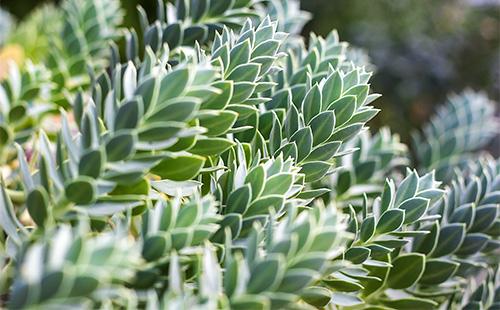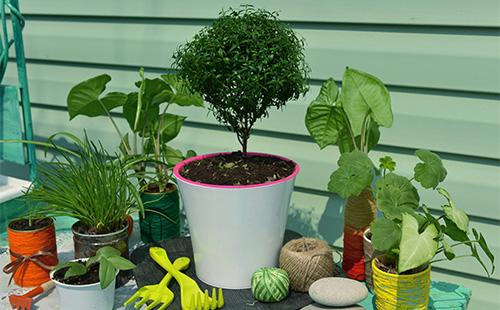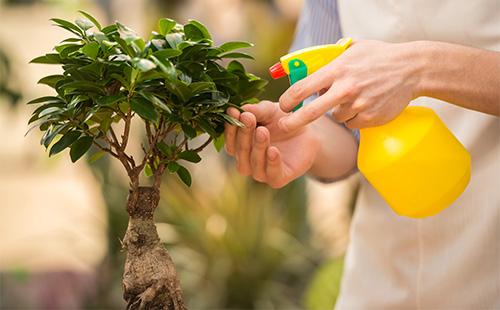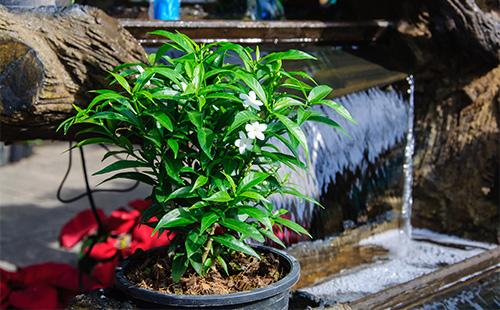The content of the article
- 1 Botanical Description
- 2 Indoor varieties
- 3 Myrtle care after purchase
- 4 The basic rules of cultivation and a favorable microclimate
- 5 Features of landing and transplanting
- 6 Breeding methods
- 7 Subtleties of trimming
- 8 The main mistakes of flower growers
- 9 Pests and diseases
- 10 What to do if the bush is dry
In natural conditions, the myrtle reaches a height of more than 2 m. Indoor myrtle is a compact plant from half a meter to a meter high. Due to the strong branching, it grows in width, suitable for forming a bonsai tree.
Botanical Description
Myrtle is a multi-stemmed shrub. Grows fast, easy to shape. Its leaves are small, dense, slightly elongated, with a glossy surface. If you rub the leaf between your fingers, a strong spicy aroma appears. On the stem, the leaves are opposite.
The life cycle of myrtle is characterized by pronounced periods of activity - growth and rest. With the onset of cold weather, development slows down, in the spring young shoots begin to appear actively. Flowering occurs at the beginning of summer. The flowers are white or pink, single or in the form of short racemose inflorescences. The aroma is pleasant.
When kept outdoors, natural pollination by insects occurs. Indoor is easily pollinated artificially. Pollen is transferred from one flower to another with a soft brush. The fruits are dark purple, almost black. Ripened berries can be taken on seeds for propagation.
Indoor varieties
Of all the existing species, the common myrtle is used mainly in pot culture. It differs in compactness, rather rapid growth, high decorativeness. Based on the species, breeders have bred several hybrid varieties. Of the most interest are five varieties of common myrtle.
- Boetica. Compared with other varieties, it differs in larger and wider leaves. It is easily formed, forms a magnificent crown. Often used to create bonsai compositions.
- Pumila. Compact variety with small, glossy, dark green leaves.
- Glanleam gold. Variegated variety with unusual leaf color. The main color is dark green. A golden border runs along the edge of the sheet.
- Microphylla. Compact grade. Height does not exceed 60 cm. Young leaves are light, with age they become darker.
- Latifolia. The hybrid variety is distinguished by rounded leaves unusual for myrtle. The bush grows quickly, easily takes any curly shape.
The branches of the myrtle are considered a symbol of Peace, harmony, pleasure. In ancient times, the plant was an indispensable component of the bride’s wedding wreath.
Myrtle care after purchase
If you properly care for the myrtle after the purchase, it adapts faster, will begin to increase the crown. The plant is considered quite capricious, it does not tolerate stress, moving, temperature changes. So that the myrtle does not die in conditions new to it, they try to adhere to four rules.
- Do not transplant. Immediately after purchase, the plant is not transplanted - they wait until it adapts. Hasty transplantation often leads to leaf fall and death of the plant.
- Increase humidity. If the myrtle looks weakened, the leaves are dull, part of the stems are bare, greenhouse conditions are created for it. The bush is covered with a transparent plastic bag. Every day, the package is removed for a short time, the bush is sprayed. Myrtle can be kept in greenhouse conditions for up to a month.
- Kept in partial shade. For the period of adaptation, myrtle is placed in a shaded place, protected from direct sunlight.
- Protect from drafts. Even an adult, healthy bush reacts negatively to drafts. For a young, just bought plant, they are unacceptable.
Myrtle is transplanted no earlier than two weeks later. Indications for transplantation - a small pot, poor condition or poor soil composition. In other cases, it is better to postpone the transplant until spring.
The basic rules of cultivation and a favorable microclimate
Myrtle is considered to be a difficult plant to grow due to the need for high air humidity, the need to organize a cold wintering. It reacts to adverse conditions by yellowing, falling leaves. How to care for myrtle in order to achieve its stable growth and flowering? Experienced flower growers recommend paying special attention to creating a favorable microclimate and watering regime.
- Lighting. Myrtle prefers sunny places with bright diffused lighting. In summer, he is kept on the east or west window, the rest of the time - on the south. In winter, the lack of light is compensated by the installation of fluorescent lamps. In severe shading, the plant quickly loses its decorativeness - it stretches, the leaves become dull, not blooming. Rearrangement from dark to light is done carefully, gradually - myrtle does not like a sharp change in conditions of detention. In summer they put it on the balcony or drop it on a flower bed right in the pot.
- Temperature. Myrtle loves the cool. Optimum conditions of detention: 18–20˚. It can adapt to room temperature, but does not withstand the heat. It is advisable to organize a cold wintering every year at 12-15 ° C. The easiest way to achieve the desired temperature is to fence the pot from the battery with cardboard or plastic.
- Watering. One of the main care requirements is regular watering. In summer, it is correct to water myrtle abundantly, as the top layer of soil dries out, every two to three days. During the wintering period, you need to focus on the speed of soil drying, watering moderately. Drying and waterlogging of the soil is not allowed. Use only warm water with a minimum salt content. Tap water needs preliminary boiling. The liquid should not stagnate in the root system - the drainage layer is made thick, up to a third of the volume of the pot.
- Humidity. Spraying is a must for myrtle. The plant needs high humidity, up to 90%. In summer, sprayed daily, in hot weather - several times a day. The need for spraying in winter depends on the conditions of detention. At room temperature continue to spray daily or every other day, with a cold wintering - only occasionally. They take additional measures to increase air humidity - they hang the batteries with a wet cloth and place water containers on the windowsill. Once a day, bathe myrtle under a warm shower.
- Top dressing. In the warm period, fertilizers are applied regularly, with weekly intervals. Preference is given to funds with a high content of phosphorus. Suitable standard preparations for flowering plants. In winter, do not feed.
To navigate the requirements of the conditions of detention in each individual period of the year, it is enough to study the table.
Table - Conditions for indoor myrtle at different times of the year
| Period | Humidity | Lighting | Temperature | Watering | Spraying |
|---|---|---|---|---|---|
| Spring | – 60–70% | - Bright, with a little direct sun | 18–20˚С | - Abundant, with intervals of 3-4 days | - In one day |
| Summer | – 70–90% | - Vibrant, shading at noon | 20–27˚С | - Abundant, with an interval of 2-3 days | - daily; - in the heat - 2 times a day |
| Autumn | – 50–60% | - Bright, no shading | 18–20˚С | - Abundant, with an interval of 3-4 days | - In one day |
| Winter | - 40-50% with a cold wintering; - 60-70% at room temperature | - Bright lighting or artificial lighting | 12-15˚С | - Moderate as the soil surface dries | - During cold wintering, they are practically not sprayed; - when warm - every other day or every day |

Features of landing and transplanting
Until the age of three, myrtle is transplanted annually, each time slightly increasing the volume of the pot. For adults, one transplant is enough for three to four years. The soil is used loose, light, moderately nutritious. A ready-made universal floral soil mixture with the addition of chopped sphagnum and coarse sand is suitable.
The size of the pot is slightly larger than the root system, the shape is the same height and width. Large drainage holes are made at the bottom of the pot. Responsible for transplantation - for myrtle, this is a lot of stress. Adhere to a certain sequence of actions.
- Preparing for transplantation. Immediately prepare everything necessary for transplantation - soil, pot, drainage. All pre-sterilized.
- Drying the soil. Just before transplanting, myrtle is not watered. The earthball should dry out a bit. The myrtle is carefully removed from the pot along with a lump of earth.
- Creating a drainage layer. A third of the new tank is filled with pebbles, ceramic or brick chips, expanded clay. Up to half the pot add soil.
- Cleansing an earthen coma. Old land is not completely cleaned. Only part of the outer roots are freed from the ground. It is convenient to straighten the roots with a wooden skewer.
- Root treatment. If there are dried or rotten roots, they are pruned. Slices are treated with coal powder and Kornevin.
- Bush transplant. Set myrtle in the center of a new pot, carefully straighten the roots, fill it with soil. The soil is carefully compacted with your fingers, taking care not to damage the roots.
For quick adaptation in a new pot, you need to take into account the peculiarities of caring for myrtle after transplantation. The tree is immediately watered, sprayed. About a week they keep in partial shade, regularly sprayed. It will be beneficial to water a weak solution of the growth stimulator Epin. When new shoots appear, the myrtle is rearranged to its old place.
Breeding methods
Propagate an ordinary myrtle is not difficult. Its cuttings are easily rooted, the seeds sprout quickly. At home, you can get seeds by artificial pollination of flowers.
Cuttings
It is easiest to root cuttings in the summer. You can cut healthy plants from the age of two years. Cuttings cut 7-10 cm long from lignified lateral shoots. The lower leaves immediately break off.Then they operate in four stages.
- Processing slices. The slice is treated with any growth stimulator. The most common drugs are Kornevin, Heteroauxin.
- Rooting cuttings. Rooted shoots are rooted in two ways - in water and directly in the ground. When using the second method, each branch is immediately planted in a separate glass with a loose soil mixture.
- Creating greenhouse conditions. Tanks with landed cuttings are covered with plastic glasses. Keep in a bright and warm place, if necessary, illuminated with fluorescent lamps.
- Care of cuttings. Every day the greenhouse is aired, the soil is moistened as necessary.
Seeds
With prolonged storage, the seed material loses its germination capacity. Therefore, flower growers prefer to use seeds from their plants. To obtain strong seedlings, it is recommended to act in five steps.
- Soak. At night, the seeds are soaked in a weak solution of potassium permanganate.
- Soil preparation. Small peat is mixed with sand, calcined in a pan. The prepared mixture is filled in a small container.
- Sowing seeds. Seeds are evenly distributed on the surface of the soil, slightly sprinkled with soil or fine sand.
- Creation of conditions. The soil is moistened, the container is covered with polyethylene, glass or closed with a transparent cover. The greenhouse is kept in a bright, warm place at a temperature of at least 22 ° C.
- Pick Seedlings are shown in one to two weeks. At the stage of four true leaves, seedlings can be planted in separate small pots.

Subtleties of trimming
Myrtle is a flexible and pliable plant. The natural form of the bush is pyramidal. But you can form a myrtle in the form of a ball or a fancy bonsai tree. To do this, use the methods of pinching, trimming, set the direction of growth, fixing individual shoots with wire.
To form a spherical crown, the growth points of the upper branches are cut off at the bush that has grown to the desired height, the lower branches are removed or shortened. Next, young shoots are systematically pinched: the upper ones after the fourth pair of leaves, the lower ones after the second.
Frequent pinching stimulates branching, but inhibits flowering. Therefore, sometimes you can give the tree a little rest. Myrtle grows quickly enough - the formation of a bush from a seedling takes about four years.
The main mistakes of flower growers
Even experienced flower growers sometimes make mistakes. Myrtle is a difficult plant to care for, so it is not always possible to avoid problems. Common care errors and their consequences are shown in the table.
Table - Common Myrtle Care Errors
| Description of the problem | What is the reason | Help the plant |
|---|---|---|
| Leaves turn yellow and curl. | - lack of moisture; - dry air | - Myrtle is abundantly watered; - placed in a greenhouse from a plastic bag; - sprayed daily |
| Leaves fall, the ends of the shoots turn black | - Heat and dry air in winter; - decay of the root system | - Myrtle is systematically sprayed if it hibernates at room temperature; - transplanted, cut damaged roots |
| Leaves fade, shoots stretch | - lack of light | - In the summer they are placed on the most lighted window; - in winter, install additional lighting |
| Leaves fold, lose light | - excess sun | - Rearrange in a slightly shaded place; - temporarily increase watering and spraying |
| Myrtle does not bloom | - Warm wintering; - too much pruning; - a spacious pot; - lack of sunlight; - lack of nutrients | - To stimulate flowering, strictly adhere to all recommendations for caring for the plant |
| Myrtle grows slowly | - Lack of nutrition; - insufficient amount of soil | - Systematically feed; - transplanted into a spacious pot |

Pests and diseases
Myrtle rarely gets sick. The only disease to be wary of is root rot. The main reasons: fungus, abundant watering during the cold wintering, poor drainage, dense soil. Outwardly, it is manifested by the blackening of the ends of young shoots, massive yellowing and falling of leaves.
Treatment begins immediately - the myrtle is taken out of the pot, and lowered for half an hour into a fungicide solution. Soaked soil is removed, damaged roots are trimmed, planted in a new sterile soil.
Pests are a more common problem. Myrtle is often affected by a spider mite, whiteflyaphids. The main causes of pest attacks are proximity to infected plants, violation of conditions. More detailed information on pests is given in the table.
Table - Myrtle Pests
| Pest name | External signs | Ways to fight | Preventative measures |
|---|---|---|---|
| Whitefly | - Wither and turn yellow leaves; - small white flies appear on the plant; - green larvae are found on the underside of the leaves; | - Myrtle washed in a warm shower; - the plant is exposed to cold for several hours (not lower than 6 ° C); - sprayed with the insecticide "Admiral" or "Kinmix" | - Systematically inspect myrtle and neighboring plants; - prophylactically treated with means containing permethrin |
| Spider mite | - The leaves turn yellow and crumble; - a barely noticeable web appears | - Myrtle is treated with soapy water, washed in the shower with clean water; - sprayed with the drug "Actara"; - for several days put on a myrtle a plastic bag | - Regularly spray the plant; - increase humidity by any means |
| Aphid | - Young shoots are twisted, deformed, covered with sticky secretions of insects | - Twisted tops trimmed; - treated with soapy water; - sprayed with a preparation based on permethrin or tobacco dust infusion | - Regularly inspect the plant; - when planted in the summer on the street they protect from ants |
| Shield | - Brownish dense plaques appear on the leaves; - sticky secretions remain from insects on the stems; - myrtle withers, dries | - The leaves with shields are sheared with manicure scissors; - insects are removed from the stems with tweezers or a brush; - treat the myrtle with a soaped sponge and rinse under the shower; - sprayed with the drug "Actellic" | - Regularly inspect myrtle; - do not put new plants nearby |

What to do if the bush is dry
If the myrtle is withered, it is not thrown away. The plant is carefully inspected. As long as the branches remain resilient, there is still a chance to reanimate the bush. First, the myrtle is bathed under a warm shower, watered abundantly and sprayed with Epin. Put on a plastic bag, put in a shaded place. Every day the package is removed, the plant is well sprayed. The procedure is repeated for a week.
Then the shelter is removed, the branches are examined again. Cut dried shoots to the live part. Watered regularly - the soil should always be moist. Once every two weeks, Zircon is added to water for irrigation. The recommended concentration is three drops per glass of water. If there are still living kidneys on the myrtle, these procedures will help them wake up. After two to three weeks, young shoots should appear on the plant.
Growing ordinary myrtle at home is not an easy, but fascinating activity. For good care, the plant will thank you with a beautiful flowering. And the essential oils contained in the leaves will fill the house with aroma, will have a beneficial effect on health.

